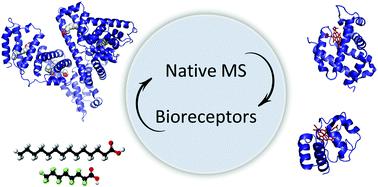Our official English website, www.x-mol.net, welcomes your feedback! (Note: you will need to create a separate account there.)
Native mass spectrometry for the design and selection of protein bioreceptors for perfluorinated compounds
Analyst ( IF 4.2 ) Pub Date : 2021-1-18 , DOI: 10.1039/d0an02005b Elise Daems 1, 2, 3, 4, 5 , Giulia Moro 1, 2, 3, 4, 6 , Herald Berghmans 2, 4, 7, 8 , Ligia M. Moretto 9, 10, 11, 12 , Silvia Dewilde 2, 4, 7, 8 , Alessandro Angelini 9, 10, 11, 12, 13 , Frank Sobott 2, 3, 4, 5, 14 , Karolien De Wael 1, 2, 3, 4, 6
Analyst ( IF 4.2 ) Pub Date : 2021-1-18 , DOI: 10.1039/d0an02005b Elise Daems 1, 2, 3, 4, 5 , Giulia Moro 1, 2, 3, 4, 6 , Herald Berghmans 2, 4, 7, 8 , Ligia M. Moretto 9, 10, 11, 12 , Silvia Dewilde 2, 4, 7, 8 , Alessandro Angelini 9, 10, 11, 12, 13 , Frank Sobott 2, 3, 4, 5, 14 , Karolien De Wael 1, 2, 3, 4, 6
Affiliation

|
Biosensing platforms are answering the increasing demand for analytical tools for environmental monitoring of small molecules, such as per- and polyfluoroalkyl substances (PFAS). By transferring toxicological findings in bioreceptor design we can develop innovative pathways for biosensor design. Indeed, toxicological studies provide fundamental information about PFAS-biomolecule complexes that can help evaluate the applicability of the latter as bioreceptors. The toolbox of native mass spectrometry (MS) can support this evaluation, as shown by the two case studies reported in this work. The analysis of model proteins’ (i.e. albumin, haemoglobin, cytochrome c and neuroglobin) interactions with well-known PFAS, such as perfluorooctanoic acid (PFOA) and perfluorooctanesulfonic acid (PFOS), demonstrated the potential of this native MS screening approach. In the first case study, untreated albumin and delipidated albumin were compared in the presence and absence of PFOA confirming that the delipidation step increases albumin affinity for PFOA without affecting protein stability. In the second case study, the applicability of our methodology to identify potential bioreceptors for PFOS/PFOA was extended to other proteins. Structurally related haemoglobin and neuroglobin revealed a 1 : 1 complex, whereas no binding was observed for cytochrome c. These studies have value as a proof-of-concept for a general application of native MS to identify bioreceptors for toxic compounds.
中文翻译:

天然质谱用于设计和选择全氟化化合物的蛋白质生物受体
生物传感平台正在满足对用于小分子环境监测的分析工具(例如全氟烷基物质和多氟烷基物质(PFAS))日益增长的需求。通过在生物受体设计中转移毒理学发现,我们可以为生物传感器设计开发创新途径。确实,毒理学研究提供了有关PFAS-生物分子复合物的基本信息,可以帮助评估PFAS-生物分子复合物作为生物受体的适用性。如本工作报道的两个案例研究所示,本机质谱(MS)的工具箱可以支持此评估。模型蛋白的分析(即白蛋白,血红蛋白,细胞色素c和神经球蛋白)与众所周知的PFAS(例如全氟辛酸(PFOA)和全氟辛烷磺酸(PFOS))的相互作用证明了这种天然MS筛选方法的潜力。在第一个案例研究中,在存在和不存在PFOA的情况下,对未处理的白蛋白和脂质化的白蛋白进行了比较,证实了脱脂步骤增加了白蛋白对PFOA的亲和力,而不会影响蛋白质的稳定性。在第二个案例研究中,我们的方法可用于识别PFOS / PFOA的潜在生物受体的适用性扩展到了其他蛋白质。结构相关的血红蛋白和神经血红蛋白显示1:1的复合物,而未观察到细胞色素c的结合。这些研究具有作为天然MS普遍应用来鉴定有毒化合物的生物受体的概念验证的价值。
更新日期:2021-02-04
中文翻译:

天然质谱用于设计和选择全氟化化合物的蛋白质生物受体
生物传感平台正在满足对用于小分子环境监测的分析工具(例如全氟烷基物质和多氟烷基物质(PFAS))日益增长的需求。通过在生物受体设计中转移毒理学发现,我们可以为生物传感器设计开发创新途径。确实,毒理学研究提供了有关PFAS-生物分子复合物的基本信息,可以帮助评估PFAS-生物分子复合物作为生物受体的适用性。如本工作报道的两个案例研究所示,本机质谱(MS)的工具箱可以支持此评估。模型蛋白的分析(即白蛋白,血红蛋白,细胞色素c和神经球蛋白)与众所周知的PFAS(例如全氟辛酸(PFOA)和全氟辛烷磺酸(PFOS))的相互作用证明了这种天然MS筛选方法的潜力。在第一个案例研究中,在存在和不存在PFOA的情况下,对未处理的白蛋白和脂质化的白蛋白进行了比较,证实了脱脂步骤增加了白蛋白对PFOA的亲和力,而不会影响蛋白质的稳定性。在第二个案例研究中,我们的方法可用于识别PFOS / PFOA的潜在生物受体的适用性扩展到了其他蛋白质。结构相关的血红蛋白和神经血红蛋白显示1:1的复合物,而未观察到细胞色素c的结合。这些研究具有作为天然MS普遍应用来鉴定有毒化合物的生物受体的概念验证的价值。



























 京公网安备 11010802027423号
京公网安备 11010802027423号